Application of Biogas and Biomethane as Maritime Fuels: A Review of Research, Technology Development, Innovation Proposals, and Market Potentials
Abstract
1. Introduction
- “1st Generation: The source of carbon for the biofuel is sugar, lipid or starch directly extracted from a plant. The crop is actually or potentially considered to be in competition with food.”
- “2nd Generation: The biofuel carbon is derived from cellulose, hemicellulose, lignin or pectin. For example, this may include agricultural, forestry wastes or residues, or purpose-grown non-food feedstocks (e.g., Short Rotation Coppice, Energy Grasses).”
- “3rd Generation: The biofuel carbon is derived from aquatic autotrophic organisms (e.g., algae). Light, carbon dioxide and nutrients are used to produce the feedstock “extending” the carbon resource available for biofuel production.”
2. Regulations, Legislation, and Their Link to Market-Based Measures and ESG
- Revised EU ETS (aims to involve shipping in EU carbon trading);
- FuelEU Maritime (a new regulation about sustainable maritime fuels to help the transition to low carbon maritime fuels, such as biogas as it is a renewable energy source (RES));
- The revised Energy Taxation Directive (to end tax exemptions for conventional marine fuels and incentivise the uptake of alternatives. For example, bunker fuels sold in the EU for intra-EU voyage are no longer tax exempt);
- The revised Renewable Energy Directive (RED II) (introduces a target of at least 40% share of renewable energy and a GHG intensity reduction target of at least 13% by 2030 in the transport sector. It maintains the multiplier for renewable energy used by ships);
- EU Maritime MRV Regulation (requires the inclusion a lifecycle analysis methodology for fuels and common principles for fuel monitoring, verification, and accreditation. The existing EU MRV system will build upon the new EU THETIS reporting database);
- Alternative Fuel Infrastructure Directive (AFID) (seeks to raise the availability of LNG by 2025 and shore-side electricity supply in main EU ports (determined by number of calls per year) by 2030);
- Carbon Border Adjustment Mechanism (CBAM) (seeks to avoid “carbon leakage”, which either occurs “when industries transfer polluting production to other countries with less stringent climate policies, or when EU products are replaced by more carbon-intensive imports”. Carbon leakage can, therefore, undermine the EU’s climate change efforts).
2.1. Market-Based Measures of Gaseous Biofuels
2.2. Environmental, Social, and Governance Strategies of Gaseous Biofuels
3. PESTEL and SWOT Analysis of Biogas and Biomethane
4. Availability, Supply Chain, and Cost Breakdown
4.1. Regional Availability
4.2. The Biomethane WtW Supply Chain
4.3. Cost Breakdown for Biomethane to Vessel and/or to Port
5. Applicability for the Maritime Industry
5.1. Shore-Side Electricity
5.2. World Fleet and Projections
6. Biogas and Biomethane Pollutant Emissions Performance in Dual-Fuel Compression-Ignition Marine Engines
7. The Benefits of Biogas Upgrade to Biomethane
- High CO2 content that limits power output;
- H2S is acidic, which can damage the engine in a very short period;
- High residual moisture, which can impact ignition (during ICE start-up);
- Gas composition variation in quality and pressure;
- Damage of engine parts due to the combustion of siloxanes.
Biogas to Biomethane Upgrading Pathways
8. Conclusions
- Sustainability and availability in relation to the complete supply chain;
- High production costs compared to their fossil counterparts;
- Applicability of biomethane and biogas in the maritime industry.
Author Contributions
Funding
Data Availability Statement
Acknowledgments
Conflicts of Interest
Abbreviations
| CA | Chemical absorption |
| CBM | Compressed biomethane |
| CNG | Compressed natural gas |
| CII | Carbon Intensity Index |
| CSR | Corporate social responsibility |
| DNV | Det Norske Veritas |
| DWT | Deadweight tonnage |
| ECA | Emission control area |
| EEDI | Energy Efficiency Design Index |
| EEXI | Energy Efficiency Existing Ship Index |
| EGR | Exhaust gas recirculation |
| ESG | Environmental, social, and governance |
| ETS | Emissions Trading Schemes |
| GHG | Greenhouse gases |
| HFO | Heavy fuel oil |
| ICE | Internal combustion engine |
| IMO | International Maritime Organization |
| LBM | Liquefied biomethane |
| LCA | Life cycle assessment |
| LCC | Life cycle costing |
| LNG | Liquefied natural gas |
| LPG | Liquefied propane gas |
| MARPOL | International Convention for the Prevention of Pollution from Ships |
| MBMs | Market-based measures |
| MEPC | Marine Environment Protection Committee |
| MGO | Marine gas oil |
| MS | Membrane separation |
| NEB | Net energy balance |
| NECA | Nitrogen emission control area |
| OPEX | Operational expenditure |
| PESTEL | Political, economic, social, technological, environmental, and legal factors |
| PSA | Pressure swing adsorption |
| RED | Revised Renewable Energy Directive |
| RES | Renewable energy source |
| RTDI | Research, technology, development, and innovation |
| SECA | Sulphur emission control areas |
| SEEMP | Ship energy efficiency management plan |
| SECA | Sulphur emission control area |
| SSE | Shore-side electricity |
| SWOT | Strengths, weaknesses, opportunities, and threats |
| TRL | Technological readiness level |
| ULSFO | Ultra-low sulphur fuel oil |
| VLSFO | Very low sulphur fuel oil |
| WS | Water scrubbing |
| WtT | Well-to-tank |
| WtW | Well-to-take |
References
- Mallouppas, G.; Yfantis, E. Decarbonization in Shipping Industry: A Review of Research, Technology Development, and Innovation Proposals. J. Mar. Sci. Eng. 2021, 9, 415. [Google Scholar] [CrossRef]
- Nisiforou, O.; Shakou, L.; Margou, A.; Charalambides, A. A Roadmap towards the Decarbonization of Shipping: A Participatory Approach in Cyprus. Sustainability 2022, 14, 2185. [Google Scholar] [CrossRef]
- Oh, Y.-K.; Hwang, K.-R.; Kim, C.; Kim, J.R.; Lee, J.-S. Recent developments and key barriers to advanced biofuels: A short review. Bioresour. Technol. 2018, 257, 320–333. [Google Scholar] [CrossRef] [PubMed]
- UNCTAD. The Biofuels Market: Current Situation and Alternative Scenarios; United Nations Conference on Trade and Development, United Nations: Geneva, Switzerland; New York, NY, USA, 2009. [Google Scholar]
- Mofor, L.; Nuttall, P.; Newell, A. Renewable Energy Options for Shipping; Technology Brief; IRENA, Innovation and Technology Centre: Bonn, Germany, 2015. [Google Scholar]
- Kumar, R.; Dhurandhar, R.; Chakrabortty, S.; Ghosh, A.K. Downstream process: Toward cost/energy effectiveness. In Handbook of Biofuels; Academic Press: Bhopal, India, 2021; pp. 249–260. [Google Scholar]
- Abdullah, B.; Muhammad, S.A.F.; Shokravi, Z.; Ismail, S.; Kassim, K.A.; Mahmood, A.N.; Aziz, M.M.A. Fourth generation biofuel: A review on risks and mitigation strategies. Renew. Sustain. Energy Rev. 2019, 107, 37–50. [Google Scholar] [CrossRef]
- Doliente, S.S.; Narayan, A.; Tapia, J.F.D.; Samsatli, N.J.; Zhao, Y.; Samsatli, S. Bio-aviation Fuel: A Comprehensive Review and Analysis of the Supply Chain Components. Front. Energy Res. 2020, 8, 110. [Google Scholar] [CrossRef]
- Ardolino, F.; Cardamone, G.; Parrillo, F.; Arena, U. Biogas-to-biomethane upgrading: A comparative review and assessment in a life cycle perspective. Renew. Sustain. Energy Rev. 2021, 139, 110588. [Google Scholar] [CrossRef]
- European Commission. Directive (EU) 2015/1513 of the European Parliament and of the Council of 9 September 2015; European Commission: Brussels, Belgium, 2015. [Google Scholar]
- Patterson, T.; Esteves, S.; Dinsdale, R.; Guwy, A. An evaluation of the policy and techno-economic factors affecting the potential for biogas upgrading for transport fuel use in the UK. Energy Policy 2011, 39, 1806–1816. [Google Scholar] [CrossRef]
- DNV. Maritime Forecast to 2050. In Energy Transition Outlook 2022; DNV: Bærum, Norway, 2022. [Google Scholar]
- Hsieh, C.-w.C.; Felby, C. Biofuels for the Marine Shipping Sector. IEA Bioenergy. 2017. Available online: https://www.ieabioenergy.com/wp-content/uploads/2018/02/Marine-biofuel-report-final-Oct-2017.pdf (accessed on 10 December 2022).
- Nelissen, D.; Faber, J.; van der Veen, R.; van Grinsven, A.; Shanthi, H.; van den Toorn, E. Availability and costs of liquefied bio- and synthetic methane. In The Maritime Shipping Perspective; CE Delft: Delft, The Netherlands, 2020. [Google Scholar]
- Brynolf, S.; Fridell, E.; Andersson, K. Environmental assessment of marine fuels: Liquefied natural gas, liquefied biogas, methanol and bio-methanol. J. Clean. Prod. 2014, 74, 86–95. [Google Scholar] [CrossRef]
- ABS. ABS Regulatory News Marpol Annex VI—Biofuels as Marine Fuels; AMERICAN Bureau of Shipping: Houston, TX, USA, 2022. [Google Scholar]
- IMO. Unified Interpretations to Marpol Annex VI Mepc.1/Circ.795/Rev.6; International Maritime Organisation: London, UK, 2022. [Google Scholar]
- IMO. Guidance on the Development of a Ship Implementation Plan for the Consistent Implementation of the 0.50% Sulphur Limit under Marpol Annex VI Mepc.1/Circ.878; International Maritime Organisation: London, UK, 2018. [Google Scholar]
- Gustafsson, M.; Anderberg, S. Biogas policies and production development in Europe: A comparative analysis of eight countries. Biofuels 2022, 13, 931–944. [Google Scholar] [CrossRef]
- IMO. Market-Based Measures. 2019. Available online: https://www.imo.org/en/OurWork/Environment/Pages/Market-Based-Measures.aspx (accessed on 15 December 2022).
- Lagouvardou, S.; Psaraftis, H.N.; Zis, T. A literature survey on market-based measures for the decarbonisation of shipping. Sustainability 2020, 12, 3953. [Google Scholar] [CrossRef]
- Psaraftis, H.N. Market-based measures for greenhouse gas emissions from ships: A review. WMU J. Marit. Aff. 2012, 11, 211–232. [Google Scholar] [CrossRef]
- Psaraftis, H.N.; Zis, T.; Lagouvardou, S. A comparative evaluation of market based measures for shipping decarbonization. Marit. Transp. Res. 2021, 2, 100019. [Google Scholar] [CrossRef]
- Dathe, T.; Dathe, R.; Dathe, I.; Helmold, M. Corporate Social Responsibility (CSR), Sustainability and Environmental Social Governance (ESG); Approaches to Ethical Management; Springer: Cham, Switzerland, 2022. [Google Scholar]
- Deloitte. ESG in the Shipping Sector. The Role of ESG in the Evaluation of Shipping Companies. Deloitte. Available online: https://www2.deloitte.com/content/dam/Deloitte/gr/Documents/consumer-business/gr_esg_in_the_shipping_sector_noexp.pdf (accessed on 15 December 2022).
- DNV. ESG in Maritime-Acting Now for a Sustainable Future. DNV. 2022. Available online: https://www.dnv.com/services/esg-in-maritime-acting-now-for-a-sustainable-future-202006 (accessed on 16 December 2022).
- CMMI. BioCH4-to-Market. Cyprus Marine and Maritime Institute. 2022. Available online: https://www.cmmi.blue/bioch4-to-market/ (accessed on 16 December 2022).
- CMMI. bioCNG-to-Cold Ironing. Cyprus Marine and Maritime Institute. 2023. Available online: https://www.cmmi.blue/biocng-to-cold-ironing/ (accessed on 1 December 2022).
- Fonden Mærsk Mc-Kinney Møller Center. Accelerating Deployment of Low-LCI Biomethane in Shipping. Fonden Mærsk Mc-Kinney Møller Center. 2022. Available online: https://www.zerocarbonshipping.com/projects/accelerating-deployment-of-low-lci-biomethane-in-shipping/ (accessed on 20 December 2022).
- CMA; CGM; ENGIE. CMA CGM and ENGIE Set to co-Invest in the Salamander Project, to Produce Second-Generation Biomethane. CMA CGM. 2022. Available online: https://cmacgm-group.com/en/news-media/salamander-project-with-engie-to-produce-second-generation-biomethane (accessed on 1 December 2022).
- Attero. FirstBio2Shipping: First Bio-LNG Production Plant for Marine Shipping. Attero. 2021. Available online: https://climate.ec.europa.eu/system/files/2022-07/if_pf_2021_firstbior2ship_en.pdf (accessed on 15 December 2022).
- IMO. Marine Environment Protection Committee (MEPC)—79th session, 12–16 December 2022. International Maritime Organisation. 16 December 2022. Available online: https://www.imo.org/en/MediaCentre/MeetingSummaries/Pages/MEPC-79-Preview.aspx (accessed on 21 December 2022).
- Fore, S.R.; Porter, P.; Lazarus, W. Net energy balance of small-scale on-farm biodiesel production from canola and soybean. Biomass Bioenergy 2011, 35, 2234–2244. [Google Scholar] [CrossRef]
- Vanek, F.; Albright, L.; Angenent, L. Energy Systems Engineering: Evaluation and Implementation, 2nd ed.; Mc Graw Hill: New York, NY, USA, 2012. [Google Scholar]
- Ghadiryanfar, M.; Rosentrater, K.A.; Keyhani, A.; Omid, M. A review of macroalgae production, with potential applications in biofuels and bioenergy. Renew. Sustain. Energy Rev. 2016, 54, 473–481. [Google Scholar] [CrossRef]
- Milledge, J.J.; Heaven, S. Energy Balance of Biogas Production from Microalgae: Effect of Harvesting Method, Multiple Raceways, Scale of Plant and Combined Heat and Power Generation. J. Mar. Sci. Eng. 2017, 5, 9. [Google Scholar] [CrossRef]
- Gegg, P.; Wells, V. UK Macro-Algae Biofuels: A Strategic Management Review and Future Research Agenda. J. Mar. Sci. Eng. 2017, 5, 32. [Google Scholar] [CrossRef]
- IEA. Outlook for Biogas and Biomethane: Prospects for Organic Growth; IEA: Paris, France, 2020. [Google Scholar]
- Daioglou, V.; Doelmana, J.C.; Wicke, B.; Faaij, A.; van Vuurena, D.P. Integrated assessment of biomass supply and demand in climate change mitigation scenarios. Glob. Environ. Chang. 2019, 54, 88–101. [Google Scholar] [CrossRef]
- IRENA. Global Bioenergy Supply and Demand Projections: A Working Paper for REmap 2030; International Renewable Energy Agency (IRENA): Abu Dhabi, United Arab Emirates, 2014. [Google Scholar]
- Alberici, S.; Grimme, W.; Toop, G. Biomethane Production Potentials in the EU. Feasibility of REPowerEU 2030 Targets, Production Potentials in the Member States and Outlook to 2050; A Gas for Climate Report; Guidehouse Netherlands B.V. for Gas for Climate: Utrecht, The Netherlands, 2022. [Google Scholar]
- Commission, E. Communication from the Commission to the European Parliament, the European Council, the Council, the European Economic and Social Committee and the Committee of the Regions Repowereu Plan {SWD(2022) 230 Final}; European Commission: Brussels, Belgium, 2022. [Google Scholar]
- BP. Statistical Review of World Energy, 2021, 70th ed.; BP: London, UK, 2021. [Google Scholar]
- IMO. ISWG-GHG 11/2/3 Development of Draft Lifecycle GHG and Carbon Intensity Guidelines for Maritime Fuels (Draft LCA Guidelines); International Maritime Organisation: London, UK, 2022. [Google Scholar]
- Noorain, R.; Kindaichi, T.; Ozaki, N.; Aoi, Y.; Ohashi, A. Biogas purification performance of new water scrubber packed with sponge carriers. J. Clean. Prod. 2019, 214, 103–111. [Google Scholar] [CrossRef]
- Agarwal, A.K.; Pandey, A.; Gupta, A.K.; Aggarwal, S.K.; Kushari, A. Novel Combustion Concepts for Sustainable Energy Development; Springer: New Delhi, India, 2014. [Google Scholar]
- Martínez-Lopez, A.; Romero-Filgueira, A.; Chica, M. Specific environmental charges to boost Cold Ironing use in the European Short Sea Shipping. Transp. Res. Part D 2021, 94, 102775. [Google Scholar] [CrossRef]
- Stolz, B.; Held, M.; Georges, G.; Boulouchos, K. The CO2 reduction potential of shore-side electricity in Europe. Appl. Energy 2021, 285, 116425. [Google Scholar] [CrossRef]
- Barriers and Drivers to the Implementation of Onshore Power Supply—A Literature Review. Sustainability 2022, 14, 6072. [CrossRef]
- Chakraborty, M.R.; Dawn, S.; Saha, P.K.; Basu, J.B.; Ustun, T.S. A Comparative Review on Energy Storage Systems and Their Application in Deregulated Systems. Batteries 2022, 8, 124. [Google Scholar] [CrossRef]
- Mazloomi, K.; Gomes, C. Hydrogen as an energy carrier: Prospects and challenges. Renew. Sustain. Energy Rev. 2012, 16, 3024–3033. [Google Scholar] [CrossRef]
- Mallouppas, G.; Ioannou, C.; Yfantis, E.A. A Review of the Latest Trends in the Use of Green Ammonia as an Energy Carrier in Maritime Industry. Energies 2022, 15, 1453. [Google Scholar] [CrossRef]
- Yfantis, E.; Mallouppas, G.; Ktoris, A.; Ioannou, C. Fit for 55—Impact on Cypriot Shipping Industry. Preliminary Report—Assessment of the New Measures and Their Effect on the Shipping Industry and the Relevant Cyprus Economy Sectors; Submitted to the Ministry of Energy Commerce and Industry; CMMI: Larnaka, Cyprus, 2022. [Google Scholar]
- Bernatik, A.; Senovsky, P.; Pitt, M. LNG as a potential alternative fuel—Safety and security of storage facilities. J. Loss Prev. Process. Ind. 2011, 24, 19–24. [Google Scholar] [CrossRef]
- EBA. TOTAL and CMA CGM Complete World’s Largest Liquified Natural Gas Bunkering Operation at Port of Rotterdam. European Biogas Association. 16 November 2020. Available online: https://www.europeanbiogas.eu/total-and-cma-cgm-complete-worlds-largest-liquified-natural-gas-bunkering-operation-at-port-of-rotterdam/ (accessed on 16 December 2022).
- IHS Markit Global Sarl. SeaWeb; S&P Global Maritime & Trade. 2022. Available online: https://maritime.ihs.com/Account2/Index (accessed on 22 December 2022).
- Bilousov, I.; Bulgakov, M.; Savchuck, V. Modern Marine Internal Combustion Engines: A Technical and Historical Overview. In Series on Naval Architecture, Marine Engineering and Shipping; Springer: Cham, Switzerland, 2020. [Google Scholar]
- Mallouppas, G.; Yfantis, E.; Frantzis, C.; Zannis, T.; Savva, P. The Effect of Hydrogen Addition on the Pollutant Emissions of a Marine Internal Combustion Engine Genset. Energies 2022, 15, 7206. [Google Scholar] [CrossRef]
- Adnan, A.I.; Ong, M.Y.; Nomanbhay, S.; Chew, K.W.; Show, P.L. Technologies for Biogas Upgrading to Biomethane: A Review. Bioengineering 2019, 6, 92. [Google Scholar] [CrossRef]
- Frantzis, C.; Zannis, T.; Savva, P.G.; Yfantis, E.A. A Review on Experimental Studies Investigating the Effect of Hydrogen Supplementation in CI Diesel Engines—The Case of HYMAR. Energies 2022, 15, 5709. [Google Scholar] [CrossRef]
- Hashizume, T.; Miyamoto, T.; Akagawa, H.; Tsujimura, K. Emission characteristics of a MULDIC combustion diesel engine: Effects of EGR. JSAE Rev. 1999, 20, 428–430. [Google Scholar] [CrossRef]
- Hotta, Y.; Nakakita, K.; Inayoshi, M.; Ogawa, T.; Sato, T.; Yamada, M. Combustion improvement for reducing exhaust emissions in IDI diesel engine. JSAE Rev. 1997, 18, 19–31. [Google Scholar] [CrossRef]
- Bernhardt, W. Combustion technology for the improvement of engine efficiency and emission characteristics. Symp. (Int.) Combust. 1977, 16, 223–232. [Google Scholar] [CrossRef]
- Papagiannakis, R.G.; Zannis, T.C.; Kotsiopoulos, P.N.; Yfantis, E.A.; Hountalas, D.T.; Rakopoulos, C.D. Theoretical Study of the Effects of Engine Parameters on Performance and Emissions of a Pilot Ignited Natural Gas Diesel Engine. Energy 2010, 35, 1129–1138. [Google Scholar] [CrossRef]
- Zannis, T.C.; Yfantis, E.A.; Katsanis, J.S.; Pariotis, E.G.; Papagiannakis, R.G.; Mohr, H. Natural Gas Combustion in Marine Compression Ignition and Spark Ignition Engines: A Technological, Environmental and Economic Evaluation. In Proceedings of the 11th Annual Meeting on Marine Technology, Athens, Greece, 12–13 December 2017. [Google Scholar]
- Crookes, R. Comparative bio-fuel performance in internal combustion engines. Biomass Bioenergy 2006, 30, 461–468. [Google Scholar] [CrossRef]
- Shan, X.; Qian, Y.; Zhu, L.; Lu, X. Effects of EGR rate and hydrogen/carbon monoxide ratio on combustion and emission characteristics of biogas/diesel dual fuel combustion engine. Fuel 2016, 181, 1050–1057. [Google Scholar] [CrossRef]
- Mathur, H.; Babu, M.G.; Prasad, Y.; Singh, V. Performance and emission characteristics of a biogas operated compression ignition engine. In Proceedings of the National Conference on Fuels from Crops, Melbourne, Australia, 28–29 September 1981. [Google Scholar]
- Mathur, H.; Babu, M.G.; Prasad, Y.; Singh, V. Evaluation of the performance and emission characteristics of a biogas operated diesel engine. In Proceedings of the Seventh National Conference on I.C. Engines and Combustion, Surathkal, Karnataka, India; 1982. [Google Scholar]
- Mathur, H.; Babu, M.; Prasad, Y. A Thermodynamic Simulation Model for a Dual Fuel Open Combustion Chamber Compression Ignition Engine; SAE Technical Paper No. 861275; SAE: Warrendale, PA, USA, 1986. [Google Scholar]
- Mustafi, N.; Raine, R. A Study of the Emissions of a Dual Fuel Engine Operating with Alternative Gaseous Fuels; SAE Technical Paper No. 2008-01-1394; SAE: Warrendale, PA, USA, 2008. [Google Scholar]
- Qian, Y.; Sun, S.; Ju, D.; Shan, X.; Lu, X. Review of the state-of-the-art of biogas combustion mechanisms and applications in internal combustion engines. Renew. Sustain. Energy Rev. 2017, 69, 50–58. [Google Scholar] [CrossRef]
- Qian, Y.; Wang, X.; Zhu, L.; Lu, X. Experimental studies on combustion and emissions of RCCI (reactivity controlled compression ignition) with gasoline/n-heptane and ethanol/n-heptane as fuels. Energy 2015, 88, 584–594. [Google Scholar] [CrossRef]
- Lounici, M.; Loubar, K.; Tazerout, M.; Balistrou, M.; Tarabet, L. Experimental Investigation on the Performance and Exhaust Emission of Biogas–Diesel Dual-Fuel Combustion in a CI Engine; SAE Technical Paper No. 2014-01-2689; SAE: Warrendale, PA, USA, 2014. [Google Scholar]
- Barik, D.; Sivalingam, M. Performance and Emission Characteristics of a Biogas Fueled DI Diesel Engine; SAE Technical Paper No. 2013-01-2507; SAE: Warrendale, PA, USA, 2013. [Google Scholar]
- Owczuk, M.; Matuszewska, A.; Kruczynski, S.; Kamela, W. Evaluation of Using Biogas to Supply the Dual Fuel Diesel Engine of an Agricultural Tractor. Energies 2019, 12, 1071. [Google Scholar] [CrossRef]
- Shen, Y.; Linville, J.; Urgun-Demirtas, M.; Mintz, M.; Snyder, S. An overview of biogas production and utilization at full-scale wastewater treatment plants (WWTPs) in the United States: Challenges and opportunities towards energy-neutral WWTPs. Renew. Sustain. Energy Rev. 2015, 50, 346–362. [Google Scholar] [CrossRef]
- Gazda, W.; Stanek, W. Energy and environmental assessment of integrated biogas trigeneration and photovoltaic plant as more sustainable industrial system. Appl. Energy 2016, 169, 138–149. [Google Scholar] [CrossRef]
- Yağlı, H.; Koç, Y.; Köse, O.; Koç, A.; Yumrutaş, R. Optimisation of simple and regenerative organic Rankine cycles using jacket water of an internal combustion engine fuelled with biogas produced from agricultural waste. Process Saf. Environ. Prot. 2021, 155, 17–31. [Google Scholar] [CrossRef]
- Demonstration of Caterpillar C-10 Dual-Fuel Engines in MCI 102DL3 Commuter Buses. Golden, Colorado. UNT Digital Library. Available online: https://digital.library.unt.edu/ark:/67531/metadc703347/ (accessed on 18 December 2022).
- Wärtsilä. World’s First Full Scale Ammonia Engine Test—An Important Step Towards Carbon Free Shipping. Wärtsilä. 30 June 2020. Available online: https://www.wartsila.com/media/news/30-06-2020-world-s-first-full-scale-ammonia-engine-test---an-important-step-towards-carbon-free-shipping-2737809 (accessed on 20 December 2022).
- Wärtsilä. Wärtsilä Advances Future Fuel Capabilities with First Ammonia Tests. Wärtsilä. 25 March 2020. Available online: https://www.wartsila.com/media/news/25-03-2020-wartsila-advances-future-fuel-capabilities-with-first-ammonia-tests-2670619?utm_source=pres (accessed on 20 December 2022).
- Reiter, A.; Kong, S.-C. Demonstration of compression-ignition engine combustion using ammonia in reducing greenhouse gas emissions. Energy Fuels 2008, 22, 2963–2971. [Google Scholar] [CrossRef]
- Solutions, M.E. Engineering the Future Two-Stroke Green-Ammonia Engine; MAN Energy Solutions: Copenhagen, Denmark, 2019. [Google Scholar]
- Win, G.D. WinGD Sets Development Timeframe for Methanol and Ammonia Engines; Winterthur Gas & Diesel: Busan, Korea, 2021. [Google Scholar]
- McKinlay, C.; Turnock, S.; Hudson, D. Route to zero emission shipping: Hydrogen, ammonia or methanol? Int. J. Hydrogen Energy 2021, 46, 28282–28297. [Google Scholar] [CrossRef]
- DNV. Use of Methanol Fuel: Methanol as Marin Fuel: Environmental Benefits, Technology Readiness, and Economic Feasibility; DNV: Berum, Norway, 2016. [Google Scholar]
- Maersk Secures Green e-Methanol for World’s First Carbon Neutral Container Ship. Seatrade Maritime News. August 2021. Available online: https://www.seatrade-maritime.com/containers/maersk-secures-green-e-methanol-worlds-first-carbon-neutral-container-ship (accessed on 20 December 2022).
- Solutions, M.E.; World-First Order for Methanol Engine within Container Segment. MAN Energy Solutions. 27 July 2021. Available online: https://www.man-es.com/company/press-releases/press-details/2021/07/27/world-first-order-for-methanol-engine-within-container-segment (accessed on 20 December 2022).
- Biernat, K.; Samson-Brek, I.; Chlopek, Z.; Owczuk, M.; Matuszewska, A. Assessment of the Environmental Impact of Using Methane Fuels to Supply Internal Combustion Engines. Energies 2021, 14, 3356. [Google Scholar] [CrossRef]
- Zhao, H.; Peng, Z.; Ladommatos, N. Understanding of controlled auto-ignition combustion in a four-stroke gasoline engine. Proc. Inst. Mech. Eng. Part D J. Automob. Eng. 2001, 215, 1297–1310. [Google Scholar] [CrossRef]
- Kumar, B.R.; Saravanan, S. Effect of exhaust gas recirculation (EGR) on performance and emissions of a constant speed DI diesel engine fueled with pentanol/diesel blends. Fuel 2015, 160, 217–226. [Google Scholar] [CrossRef]
- Chen, Z.L.J.; Wu, Z.; Lee, C. Effects of port fuel injection (PFI) of n-butanol and EGR on combustion and emissions of a direct injection diesel engine. Energy Convers. Manag. 2013, 76, 725–731. [Google Scholar] [CrossRef]
- Abdelaal, M.; Hegab, A. Combustion and emission characteristics of a natural gas-fueled diesel engine with EGR. Energy Convers. Manag. 2012, 64, 310–312. [Google Scholar] [CrossRef]
- Ray, N.; Mohanty, M.; Mohanty, R. Biogas as Alternate Fuel in Diesel Engines: A Literature Review. IOSR J. Mech. Civ. Eng. (IOSR-JMCE) 2013, 9, 23–28. [Google Scholar] [CrossRef]
- Tansel, B.; Surita, S. Managing siloxanes in biogas-to-energy facilities: Economic comparison of pre- vs post-combustion practices. Waste Manag. 2019, 96, 121–127. [Google Scholar] [CrossRef]
- Khan, M.U.; Lee, J.T.E.; Bashir, M.A.; Dissanayake, P.D.; Ok, Y.S.; Tong, Y.W.; Shariati, M.A.; Wu, S.; Ahring, B.K. Current status of biogas upgrading for direct biomethane use: A review. Renew. Sustain. Energy Rev. 2021, 149, 111343. [Google Scholar] [CrossRef]
- Mendiara, T.; Cabello, A.; Izquierdo, M.; Abad, A.; Mattisson, T.; Adánez, J. Effect of the Presence of Siloxanes in Biogas Chemical Looping Combustion. Energy Fuels 2021, 35, 14984–14994. [Google Scholar] [CrossRef]
- Sevimoglu, O.; Tansel, B. Composition and source identification of deposits forming in landfill gas (LFG) engines and effect of activated carbon treatment on deposit composition. J. Environ. Manag. 2013, 128, 300–305. [Google Scholar] [CrossRef] [PubMed]
- Sevimoglu, O.; Tansel, B. Effect of persistent trace compounds in landfill gas on engine performance during energy recovery: A case study. Waste Manag. 2013, 33, 74–80. [Google Scholar] [CrossRef] [PubMed]
- Piechota, G.; Bartlomiej, I.; Buczkowski, R. Development of measurement techniques for determination main and hazardous components in biogas utilised for energy purposes. Energ. Convers. Manag. Technol. 2013, 68, 216–226. [Google Scholar] [CrossRef]
- Pizzuti, L.; Martins, C.; Lacava, P. Laminar burning velocity and flammability limits in biogas: A literature review. Renew. Sustain. Energy Rev. 2016, 62, 856–865. [Google Scholar] [CrossRef]
- Noyola, A.; Morgan-Sagastume, J.M.; López-Hernández, J.E. Treatment of Biogas Produced in Anaerobic Reactors for Domestic Wastewater: Odor Control and Energy/Resource Recovery. Rev. Environ. Sci. Bio/Technol. 2006, 5, 93–114. [Google Scholar] [CrossRef]
- Al Seadi, T.; Rutz, D.; Prassl, H.; Köttner, M.; Finsterwalder, T.; Volk, S.; Janssen, R. Biogas Handbook; BiG>East Project; University of Southern Denmark Esbjerg: Esbjerg, Denmark, 2008. [Google Scholar]
- Sun, Q.; Li, H.; Yan, J.; Liu, L.; Yu, Z.; Yu, X. Selection of appropriate biogas upgrading technology—A review of biogas cleaning, upgrading and utilisation. Renew. Sustain. Energy Rev. 2015, 51, 521–532. [Google Scholar] [CrossRef]
- Ahmad, N.; Mel, M.; Sinaga, N. Design of Liquefaction Process of Biogas using Aspen HYSYS Simulation. J. Adv. Res. Biofuel Bioenergy 2018, 2, 10–15. [Google Scholar]
- Joshua, O.; Ejura, G.; Bako, I.; Gbaja, I.; Yusuf, Y. Fundamental Principles of Biogas Product. Int. J. Sci. Eng. Res. 2014, 2, 47–50. [Google Scholar]
- Kriauciunas, D.; Pukalskas, S.; Rimkus, A.; Barta, D. Analysis of the Influence of CO2 Concentration on a Spark Ignition Engine Fueled with Biogas. Appl. Sci. 2021, 11, 6379. [Google Scholar] [CrossRef]
- Rimkus, A.; Stravinskas, S.; Matijošius, J. Comparative Study on the Energetic and Ecologic Parameters of Dual Fuels (Diesel–NG and HVO–Biogas) and Conventional Diesel Fuel in a CI Engine. Appl. Sci. 2020, 10, 359. [Google Scholar] [CrossRef]
- Leonzio, G. Upgrading of biogas to bio-methane with chemical absorption process: Simulation and environmental impact. J. Clean. Prod. 2016, 131, 364–375. [Google Scholar] [CrossRef]
- Angelidaki, I.; Treu, L.; Tsapekos, P.; Luo, G.; Campanaro, S.; Wenzel, H.; Kougias, P.G. Biogas upgrading and utilization: Current status and perspectives. Biotechnol. Adv. 2018, 36, 452–466. [Google Scholar] [CrossRef]
- Chen, X.Y.; Vinh-Thang, H.; Ramirez, A.A.; Rodrigue, D. Membrane gas separation technologies for biogas. RSC Adv. 2015, 5, 24399. [Google Scholar] [CrossRef]
- Olumide, W.; Yaqin, Z.; Ange, N.; Doan, P.; Nathalie, L. A Review of Biogas Utilisation, Purification and Upgrading Technologies. Waste Biomass Valo. 2017, 6, 267–283. [Google Scholar]
- Basu, S.; Khan, A.L.; Cano-Odena, A.; Liu, C.; Vankelecom, I.F.J. Membrane-based technologies for biogas separations. Chem. Soc. Rev. 2010, 39, 750–768. [Google Scholar] [CrossRef]
- Bauer, F.; Hulteberg, C.; Persson, T.; Tamm, D. Biogas Upgrading—Review of Commercial Technologies. SGC Rapport, Malmö. 2013. Available online: http://vav.griffel.net/filer/C_SGC2013-270.pdf (accessed on 21 December 2022).
- TUV—Vienna University of Technology. Biogas to Biomethane Technology Review. Promotion of Bio-Methane and Its Market Development through Local and Regional Partnerships a Project under the Intelligent Energy—Europe Programme. Contract Number: IEE/10/130, Deliverable Reference: Task 3.1.1. Vienna. 2012. Available online: https://www.membran.at/downloads/2012_BioRegions_BiogasUpgradingTechnologyReview_ENGLISH.pdf (accessed on 16 December 2022).
- Zito, P.F.; Brunetti, A.; Barbieri, G. Renewable biomethane production from biogas upgrading via membrane separation: Experimental analysis and multistep configuration design. Renew. Energy 2022, 200, 777–787. [Google Scholar] [CrossRef]
- Scholz, M.; Melin, T.; Wessling, M. Transforming biogas into biomethane using membrane technology. Renew. Sustain. Energy Rev. 2013, 17, 199–212. [Google Scholar] [CrossRef]
- Molino, A.; Migliori, M.; Ding, Y.; Bikson, B.; Giordano, G.; Braccio, G. Biogas upgrading via membrane process: Modelling of pilot plant scale and the end uses for the grid injection. Fuel 2013, 107, 585–592. [Google Scholar] [CrossRef]
- Ozturk, B.; Demirciyeva, F. Comparison of biogas upgrading performances of different mixed matrix membranes. Chem. Eng. J. 2013, 222, 209–217. [Google Scholar] [CrossRef]
- Bernardo, P.; Drioli, E.; Golemme, G. Membrane Gas Separation: A Review/State of the Art. Ind. Eng. Chem. Res. 2009, 48, 4638–4663. [Google Scholar] [CrossRef]
- Ghaiba, K.; Ben-Fares, F.-Z. Power-to-Methane: A state-of-the-art review. Renew. Sustain. Energy Rev. 2018, 81, 433–446. [Google Scholar] [CrossRef]
- Cozma, P.; Ghinea, C.; Mamaliga, I.; Wukovits, W.; Friedl, A.; Gavrilescu, M. Environmental Impact Assessment of High Pressure Water Scrubbing Biogas Upgrading Technology. Clean Soil Air Water 2013, 41, 917–927. [Google Scholar] [CrossRef]
- Budzianowski, W.M.; Wylock, C.E.; Marciniak, P.A. Power requirements of biogas upgrading by water scrubbing and biomethane compression: Comparative analysis of various plant configurations. Energy Convers. Manag. 2017, 141, 2–19. [Google Scholar] [CrossRef]
- Kohlheb, N.; Wluka, M.; Bezama, A.; Thrän, D.; Aurich, A.; Müller, R.A. Environmental-Economic Assessment of the Pressure Swing Adsorption Biogas Upgrading Technology. BioEnergy Res. 2020, 14, 901–909. [Google Scholar] [CrossRef]
- CMMI. Green Marine; CMMI: Larnaca, Cyprus, 2023; Available online: https://www.cmmi.blue/green-marine/ (accessed on 1 February 2023).

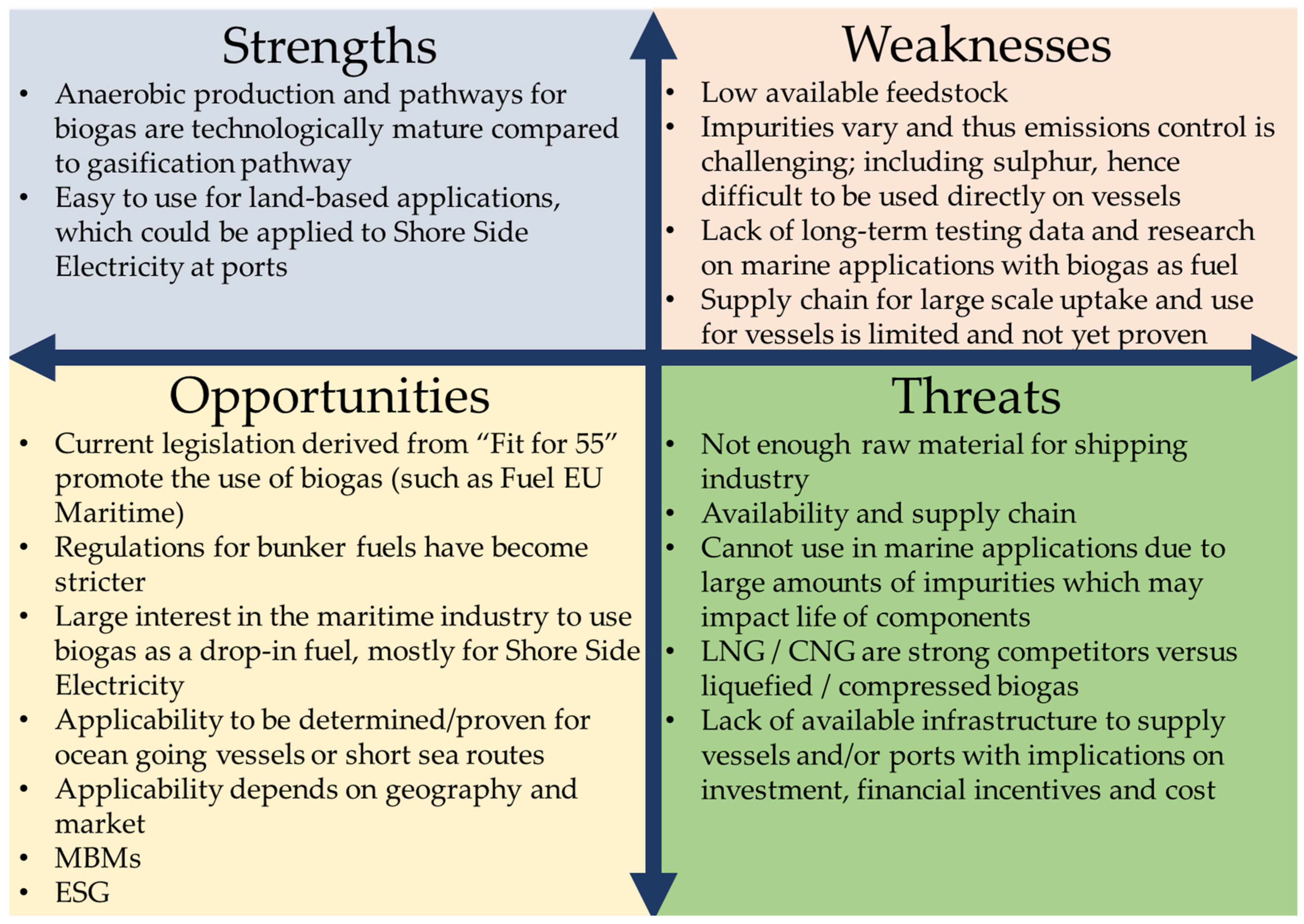
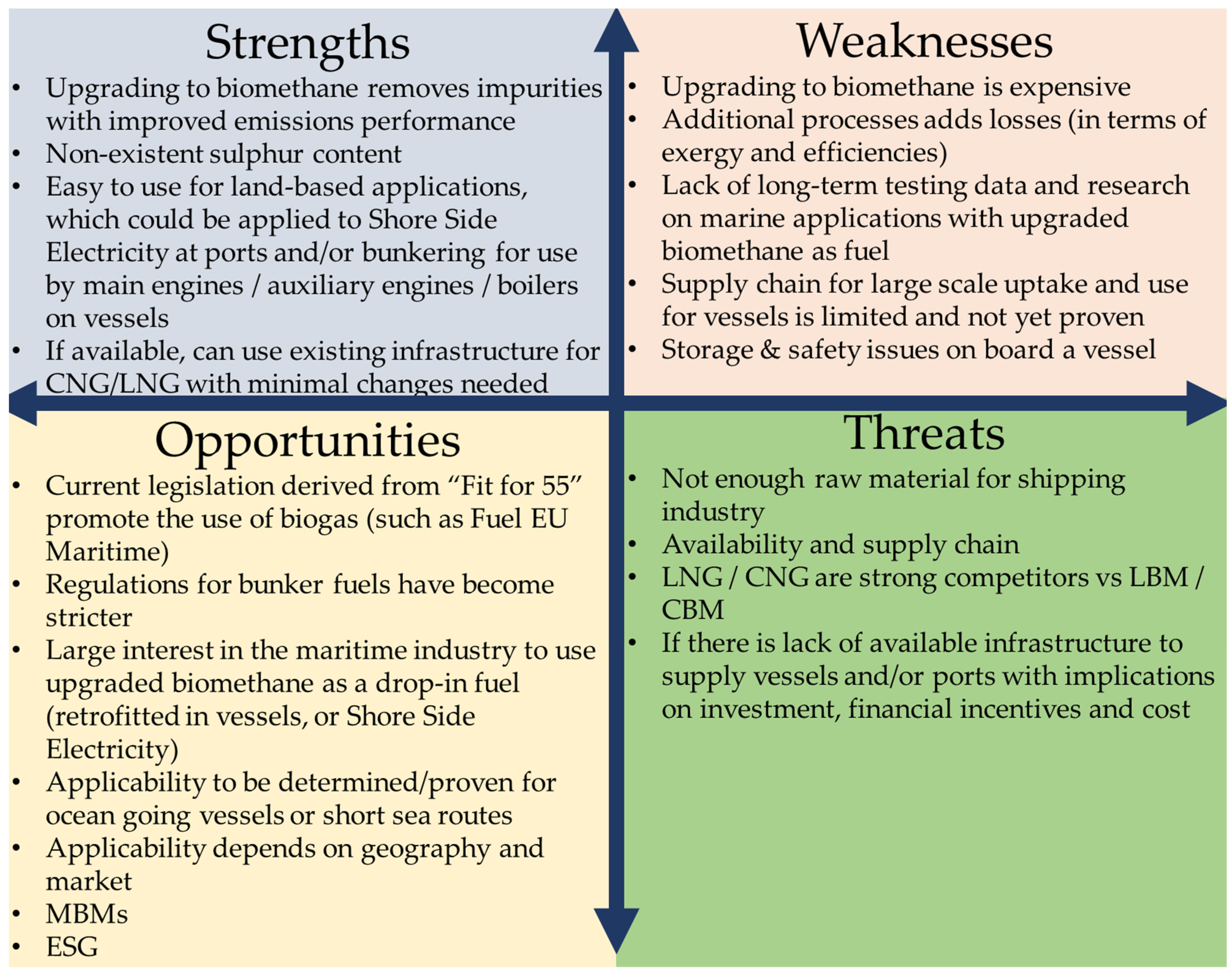
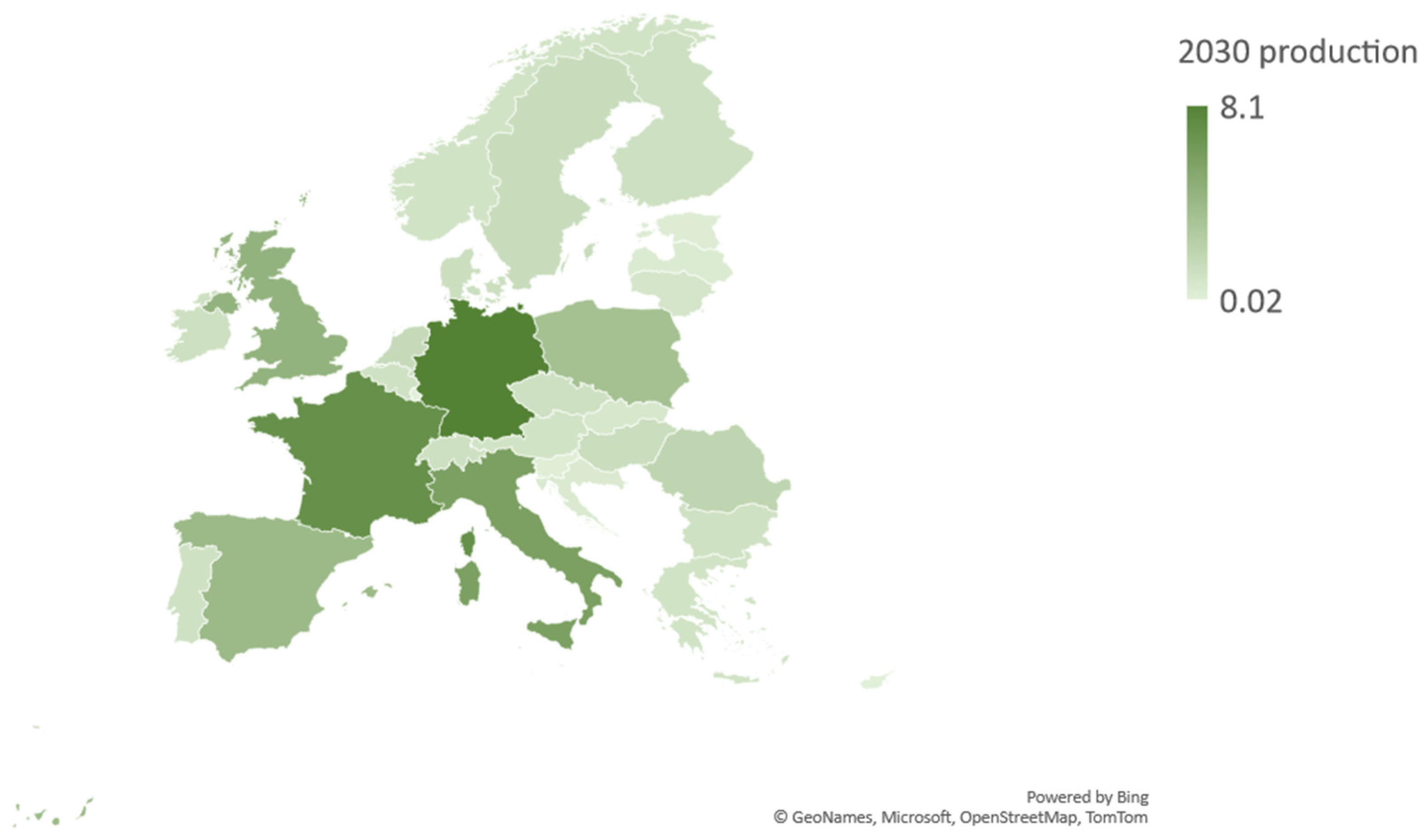



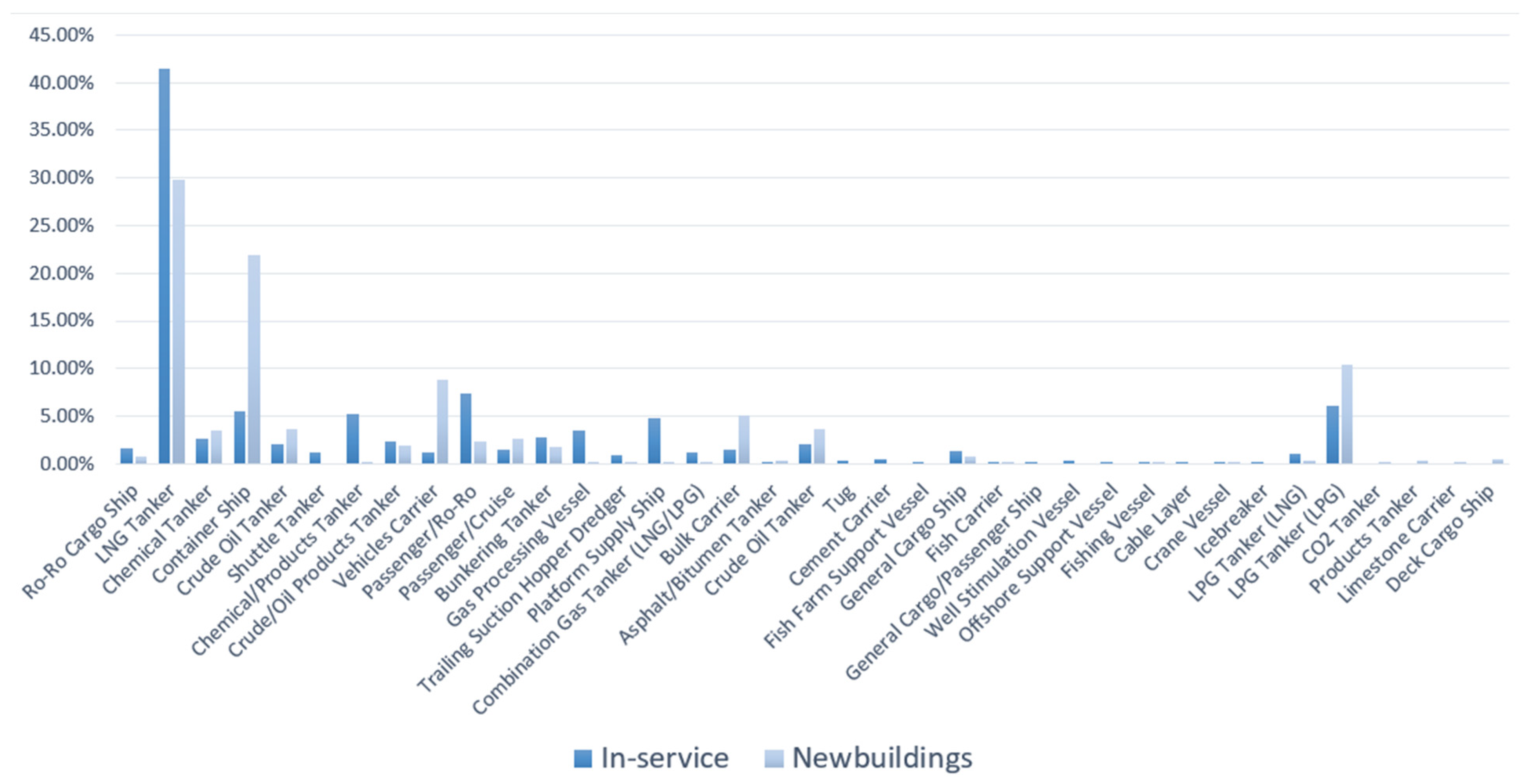
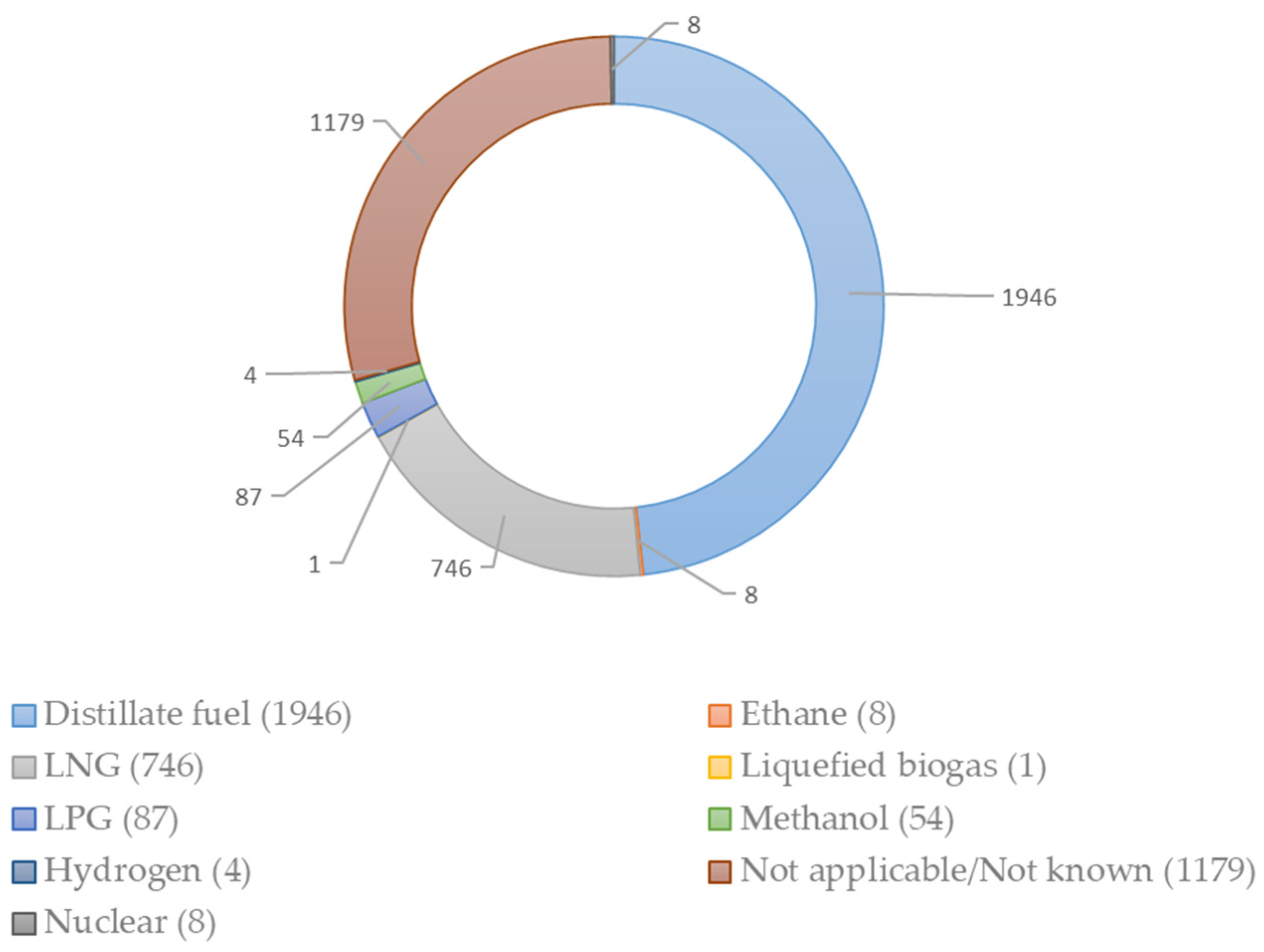

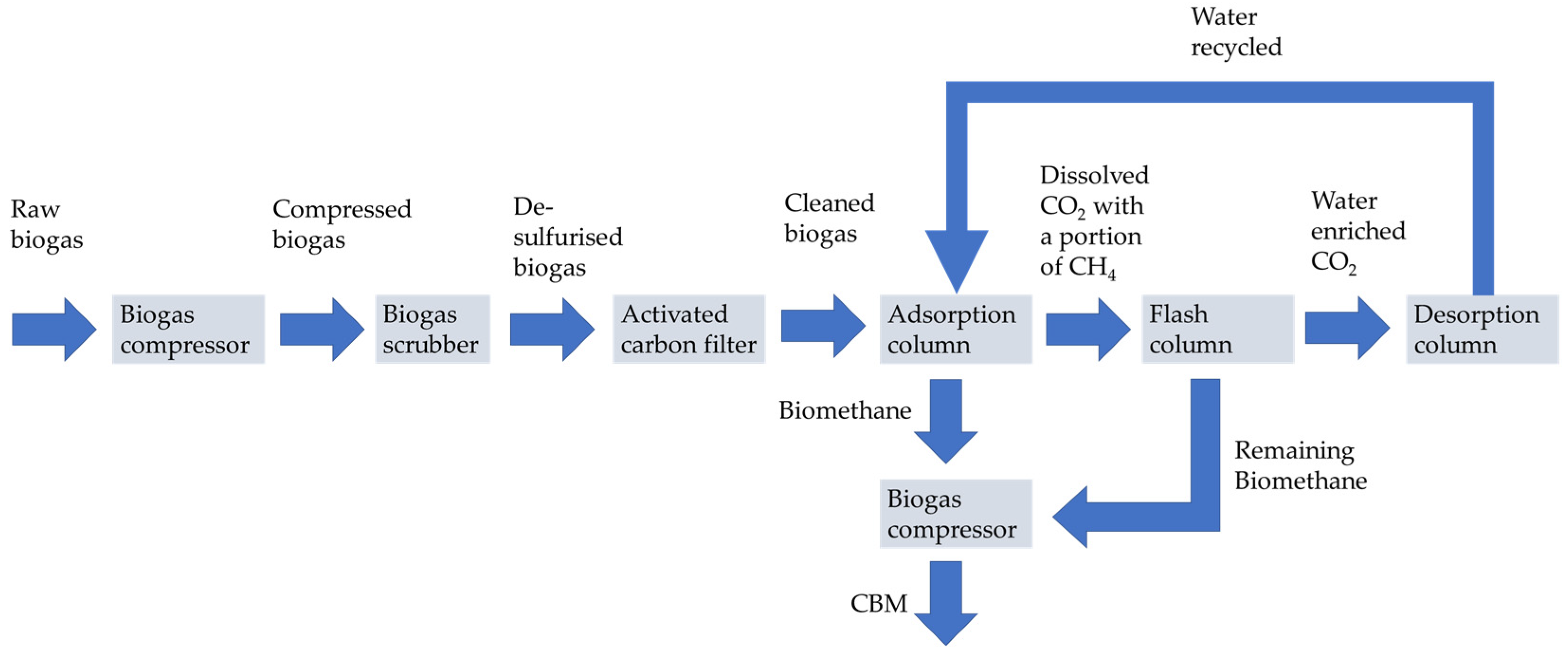
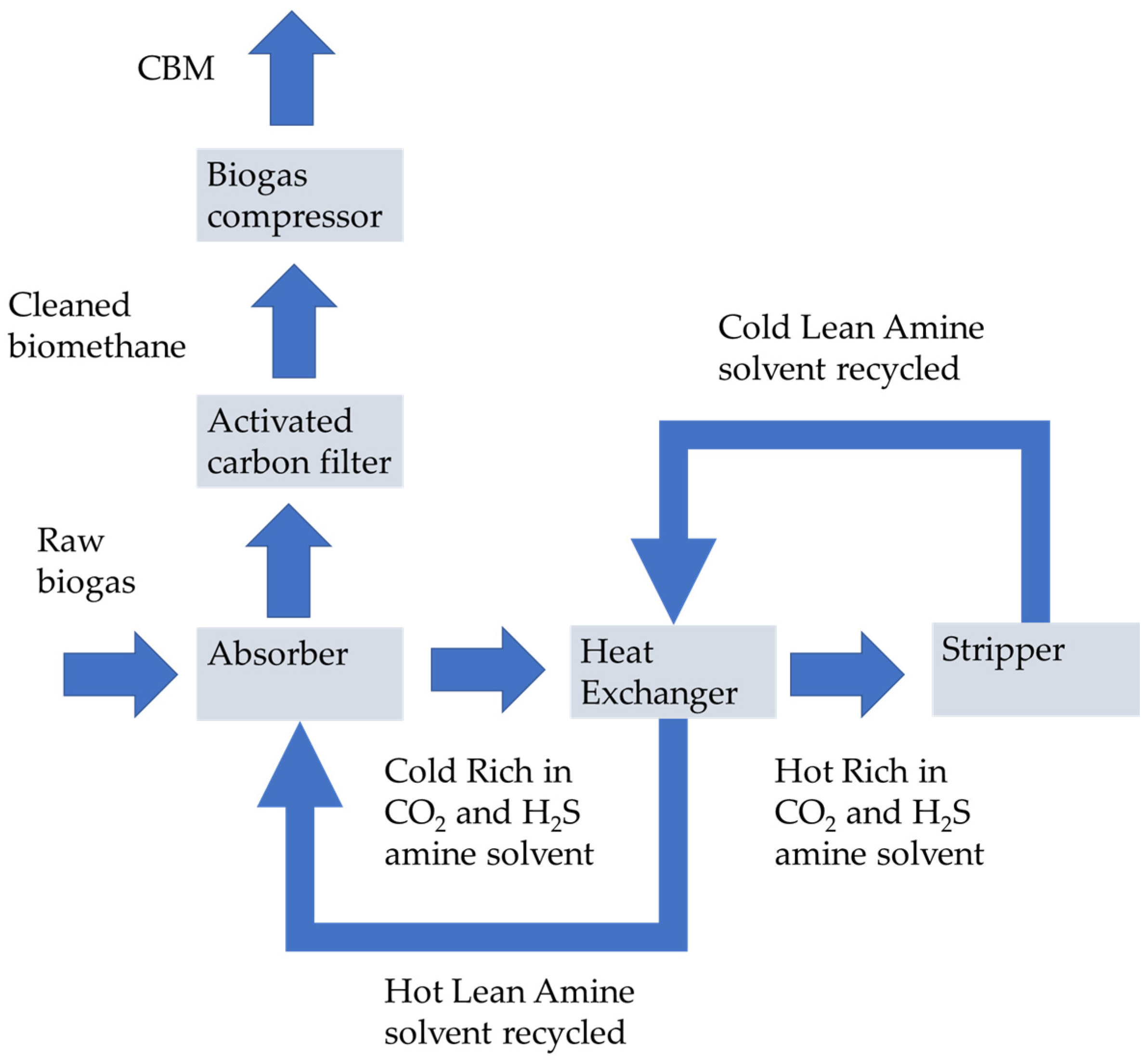
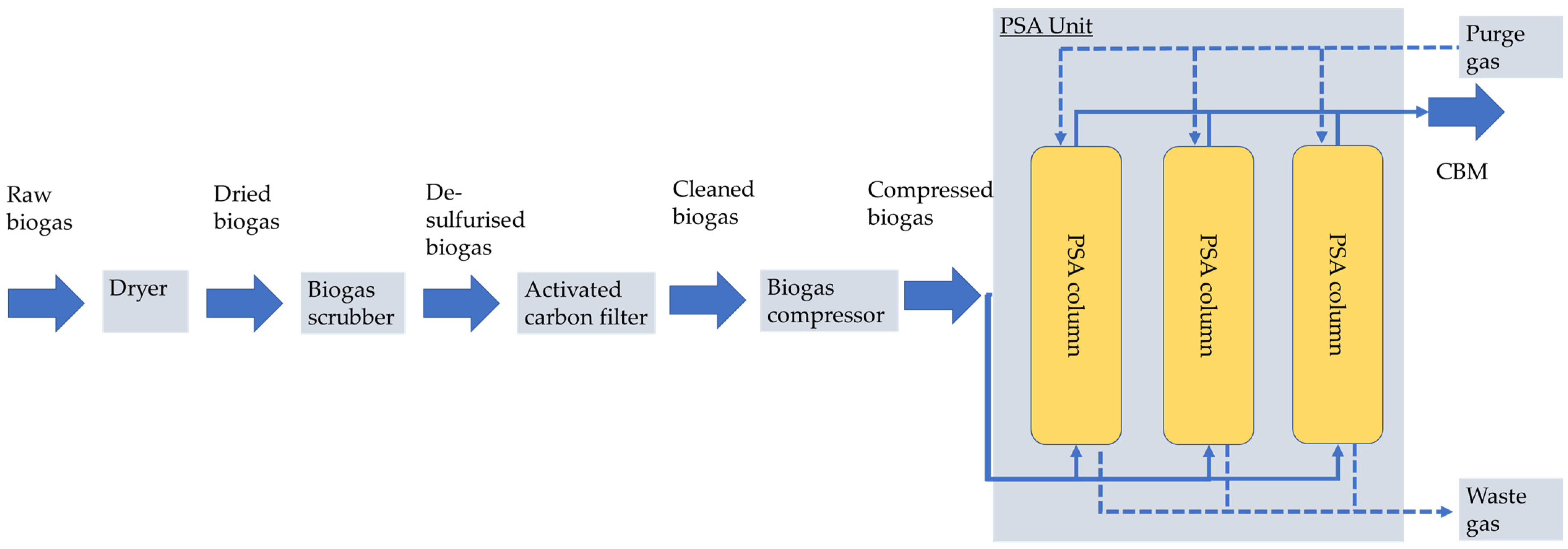
| Factor | Key Drivers | Implications on Gaseous Biofuels |
|---|---|---|
| Political | Governments adding political pressure and incentives for the promotion and use of biofuels by the shipping industry | Formation of general policies (such as from the IMO or the European Commission) that may be beneficial in the scale-up and development of biogas in one country, but may not be as beneficial in another country. |
| Economic | Investment of the shipping industry in the use of gaseous biofuels | Also highlighted within the technological factor, the shipping industry is investing (and actively participating) in RTDI technologies. |
| MBMs | Economic incentives based on MBMs (such as the ETS, i.e., reduction of carbon penalties/tax) will help the uptake of gaseous biofuels by the shipping industry. These activities are also driven and related to the minimisation of EEDI, EEXI, and CII. | |
| Socio-cultural | ESG | Gaseous biofuels will enable organisations to minimise their impact on climate change and global warming, and thus demand on gaseous biofuels will increase. Improve image of shipping industry in terms of social criteria to achieve sustainability. |
| Technological | Biogas combustion | Biogas combustion can be used for land-based applications. Therefore, in terms of shipping, biogas could be used for shore-side electricity. |
| Upgrading of biogas to biomethane | Upgrading needed to remove impurities, which when combusted are toxic to the environment and human health, and also reduce the lifetime of components in an ICE engine (see Section 7). | |
| Participation of stakeholders of the shipping industry in RTDI activities | Large activity in RTDI projects involving gaseous biofuels and their supply chain issues and upgrading of biogas to biomethane (such as BioCH4-to-Market [27], BioCNG-to-Cold Ironing [28], Accelerating deployment of low-LCI Biomethane in shipping [29], Salamander project [30], and FirstBio2Shipping [31]). The shipping industry also actively participates in these activities, for example, by providing critical access to infrastructure for testing, benchmarking, and validation. | |
| Environmental | Inclusion of additional areas under ECA/SECA/NECA | Stricter regulations on existing ECA/SECA/NECA areas, such as the Baltic Sea. For example, according to Marine Environment Protection Committee, MEPC 79, as of 2025 the Mediterranean Sea has now been included as a SECA and Particulate Matter control area [32]. In this respect, biomethane can contribute to the reduction of GHG and harmful pollutants (combusting biomethane has no SOx emissions and very low PM emissions). However, after-treatment in Nox emissions will be needed. In addition, further inclusion of additional areas will further expose the shipping industry to more stringent conditions. |
| ESG | Organisations will need to illustrate their environmental criteria, which creates opportunities for inclusion of biogas/biomethane into the net zero carbon transition plan. | |
| Legal | Lack/incomplete missing framework from IMO regarding gaseous biofuels | Utilisation of existing LNG/CNG framework for biomethane. |
| At European level, the Green Deal and the recent Fit for 55 legislation package | The directives listed in Section 1 will impose carbon penalties to the shipping industry. Utilisation of gaseous biofuels will minimise the impact. | |
| Inclusion of additional areas under ECA/SECA/NECA | See above discussion. | |
| ESG | At the moment ESG reporting is voluntary, but in the near future they may become obligatory. Hence, organisations may be forced to use biogas/biomethane. |
| Region | Percentage Upgraded (%) | ~USD/MBtu (2018) Biomethane | ~USD/MBtu (2018) Natural Gas |
|---|---|---|---|
| North America | 15 | 14.5 | 4.0 |
| South America | 35 | 12.5 | 5.2 |
| Europe | 10 | 16.0 | 7.5 |
| Asia | 2 | 17.5 | 10.0 |
| Status | LNG | Percentage LNG to World Fleet (%) | LPG | Percentage LPG to World Fleet (%) | Total World Fleet |
|---|---|---|---|---|---|
| In-service (500 DWT) | 791 | 1.14 | 52 | 0.075 | 69,130 |
| In-service (5000 DWT) | 656 | 0.95 | 49 | 0.070 | 69,130 |
| Newbuildings * (500 DWT) | 746 | 18.50 | 87 | 2.16 | 4033 |
| Newbuildings * (5000 DWT) | 696 | 17.26 | 87 | 2.16 | 4033 |
| Gas Component | Raw Biogas | Upgraded Biomethane | Natural Gas |
|---|---|---|---|
| Methane, CH4 (%) | 45.0–70.0 | 94.0–99.9 | 93.0–98.0 |
| Carbon Dioxide, CO2 (%) | 25.0–45.0 | 0.1–4.0 | 1.0 |
| Nitrogen, N2 (%) | <3.0 | <3.0 | 1.0 |
| Oxygen, O2 (%) | <2.0 | <1.0 | – |
| Hydrogen, H2 (%) | <1.0 | Traces | – |
| Hydrogen Sulfide, H2S (ppm) | 20.0–20,000.0 | <10.0 | – |
| Ammonia, NH3 (%) | Traces | Traces | – |
| Ethane, C2H6 (%) | – | – | <3.0 |
| Propane, C3H8 (%) | – | – | <2.0 |
| Siloxanes (%) | Traces | – | – |
| Water, H2O (%) | 2.0–7.0 | – | – |
| Technology | Process | Issues | Maturity/Technological Benefits |
|---|---|---|---|
| 1. Membrane separation (MS) | Utilisation of membranes that have a strong selectivity in separation, i.e., permeable to CO2, H2O, and NH3 with less permeability to O2 and H2S (these are referred to as the “permeate” flow; pass through the micro-pores and are removed), and little permeability to CH4 and N2 (these are referred to as the “retantate” flow pass through the membrane without being removed). There are three main categories for membranes based on materials: 1. Polymeric, 2. inorganic, and 3. mixed matrix. | Efficiency of membrane depends on moisture levels. | Available to market. Ardolino et al. [9] mentioned that on a LCA and LCC, the MS method has the optimal performance compared to the other available methods. Characterised by energy efficiency, simple construction, and easy scale-up. Modular and versatile nature of membrane. |
| 2. Water scrubbing (WS) | Separation is based on the different solubility of CO2 and CH4 in water. Thus, WS is favoured at low temperatures and high pressures as CO2 dissolves faster into water in the adsorption column. Some CH4 may exist after the adsorption process, and so the mixture is sent to a flash column, where an appropriate pressure drop is applied to release the remaining CH4. The CO2 is then released in the desorption column. The water is then recycled for more stable operation and less operational problems. | Methane slip of the order of 1–2%. Difficult to produce “highly purified gas” under standard conditions without the need of external pressure. When operating at low pressures (near atmospheric conditions), installations are limited to small sizes due to the large liquid-to-biogas flow ratios. | Available to market due to simplicity and performance reliability, but with high electricity costs. Therefore, the process operates at “near atmospheric conditions” to reduce electricity demand. |
| 3. Chemical absorption (CA) | Similar operating principle to WS but CA uses organic amine solvents rather than water. Note that amine solvents, found in the absorber, are more selective in absorbing CO2 compared to water. The amine solvent is also recycled into the absorber as it: (i) utilises the heat from the heat exchanger as the absorber process requires thermal energy, and (ii) CO2 is removed by the stripper. | Still developing to improve CO2 solubility. | Available to market. Smaller units compared to WS as they can absorb more CO2 per unit volume. CA can operate at atmospheric pressure, and thus with less energy consumption. CO2 and H2S are removed simultaneously. |
| 4. Pressure swing adsorption (PSA) | The PSA method separates gases via their physical properties. The raw biogas is compressed at an elevated pressure and fed into the pressure swing adsorption column, which retains CO2, but not CH4. When CO2 is saturated, it is removed via desorption in the purge gas and removed as waste gas. The PSA unit is composed of PSA columns connected in series to ensure continuous operations. | PSA technology has the lowest efficiency recovery. Methane slip varies from 1.8% to 2.0%. In addition, further gas treatment is needed to avoid the release of emissions to the environment. High energy cost; 77% of operational cost is spent on electricity. | Available to market. Could be the technology of the future, but currently cost is prohibitive due to additional gas treatment and innovative use of materials and hybrid systems (such as Zeolite 5A to purify the gas at first stage). |
Disclaimer/Publisher’s Note: The statements, opinions and data contained in all publications are solely those of the individual author(s) and contributor(s) and not of MDPI and/or the editor(s). MDPI and/or the editor(s) disclaim responsibility for any injury to people or property resulting from any ideas, methods, instructions or products referred to in the content. |
© 2023 by the authors. Licensee MDPI, Basel, Switzerland. This article is an open access article distributed under the terms and conditions of the Creative Commons Attribution (CC BY) license (https://creativecommons.org/licenses/by/4.0/).
Share and Cite
Mallouppas, G.; Yfantis, E.A.; Ioannou, C.; Paradeisiotis, A.; Ktoris, A. Application of Biogas and Biomethane as Maritime Fuels: A Review of Research, Technology Development, Innovation Proposals, and Market Potentials. Energies 2023, 16, 2066. https://doi.org/10.3390/en16042066
Mallouppas G, Yfantis EA, Ioannou C, Paradeisiotis A, Ktoris A. Application of Biogas and Biomethane as Maritime Fuels: A Review of Research, Technology Development, Innovation Proposals, and Market Potentials. Energies. 2023; 16(4):2066. https://doi.org/10.3390/en16042066
Chicago/Turabian StyleMallouppas, George, Elias Ar. Yfantis, Constantina Ioannou, Andreas Paradeisiotis, and Angelos Ktoris. 2023. "Application of Biogas and Biomethane as Maritime Fuels: A Review of Research, Technology Development, Innovation Proposals, and Market Potentials" Energies 16, no. 4: 2066. https://doi.org/10.3390/en16042066
APA StyleMallouppas, G., Yfantis, E. A., Ioannou, C., Paradeisiotis, A., & Ktoris, A. (2023). Application of Biogas and Biomethane as Maritime Fuels: A Review of Research, Technology Development, Innovation Proposals, and Market Potentials. Energies, 16(4), 2066. https://doi.org/10.3390/en16042066








